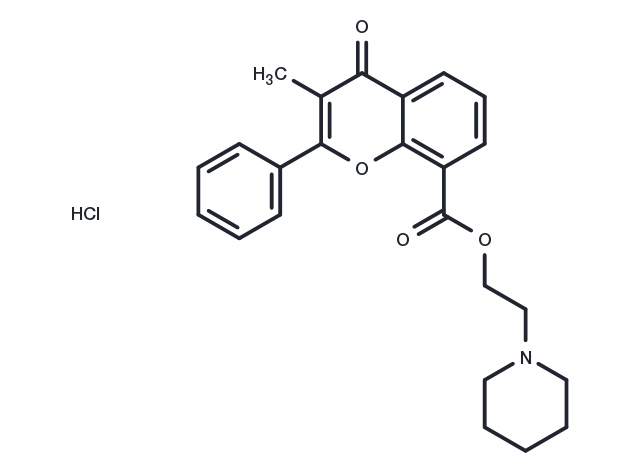Powder: -20°C for 3 years | In solvent: -80°C for 1 year


Flavoxate hydrochloride (DW61) , a muscarinic AChR antagonist, is used in the therapy of various urinary syndromes and as an antispasmodic.

| Pack Size | Availability | Price/USD | Quantity |
|---|---|---|---|
| 25 mg | In stock | $ 30.00 | |
| 50 mg | In stock | $ 43.00 | |
| 100 mg | In stock | $ 58.00 | |
| 200 mg | In stock | $ 63.00 | |
| 1 g | In stock | $ 89.00 |


| Description | Flavoxate hydrochloride (DW61) , a muscarinic AChR antagonist, is used in the therapy of various urinary syndromes and as an antispasmodic. |
| Targets&IC50 | mAChR:12.2 μM |
| In vitro | Without altering basal bladder pressure in rats, Flavoxate (3 mg/kg) can halt efferent nerve activity and associated bladder contractions for approximately 10 minutes. At the same dosage, administered intravenously, Flavoxate abolishes rhythmic bladder contractions, with maximum intervals of voiding contractions reaching 7.20 minutes. In rats, at a higher concentration (10 mg/kg), Flavoxate suppresses both the initial rapid-rise contraction phase (Phase 1) and the sustained contraction phase (Phase 2) to an equivalent degree. Furthermore, at this concentration, Flavoxate eliminates bladder contractions without altering contraction amplitude. Intracerebroventricular (ICV) injections of Flavoxate ranging from 50 to 200 mg or intrathecal (IT) injections of 100 to 200 mg dose-dependently abolish rhythmic bladder contractions within 5 to 15 minutes post-administration. |
| In vivo | Flavoxate inhibits cAMP formation in a concentration-dependent manner (0.01~10 μM) from membranes extracted from the rat cerebral cortex and striatum, an effect completely negated by pertussis toxin pretreatment. At concentrations greater than 10 μM, Flavoxate suppresses detrusor muscle contraction induced by acetylcholine, with a pD value of 4.55, and also inhibits contractions induced by Ca2+, with a pIC50 value of 4.92. Flavoxate concentration-dependently reduces K+-induced contractions of human bladder. It can displace [3H]nitrendipine at Ca2+ channel binding sites, with an IC50 of 254 μM. Flavoxate also concentration- and voltage-dependently inhibits the peak amplitude of inward Ba2+ currents sensitive to the voltage-dependent nifedipine in human detrusor smooth muscle cells (Ki: 10 μM), and inhibits the same Ba2+ currents at both 30°C (Ki = 5.1 mM) and 37°C (Ki = 4.6 mM). |
| Synonyms | Flavoxate HCl, NSC-114649, DW61, Rec-7-0040 |
| Molecular Weight | 427.92 |
| Formula | C24H26ClNO4 |
| CAS No. | 3717-88-2 |
Powder: -20°C for 3 years | In solvent: -80°C for 1 year
DMSO: 2.5 mM
You can also refer to dose conversion for different animals. More
bottom
Please see Inhibitor Handling Instructions for more frequently ask questions. Topics include: how to prepare stock solutions, how to store products, and cautions on cell-based assays & animal experiments, etc.
Flavoxate hydrochloride 3717-88-2 Neuroscience AChR lower urinary tract infections Phosphodiesterase Calcium Channel mAChR anesthetic overactive bladder Flavoxate HCl Ca2+ channels DW-61 Ca channels Inhibitor NSC-114649 antispasmodic DW61 inhibit NSC114649 muscarinic NSC 114649 DW 61 Muscarinic acetylcholine receptor Flavoxate Hydrochloride Rec-7-0040 Phosphodiesterase (PDE) Flavoxate inhibitor
